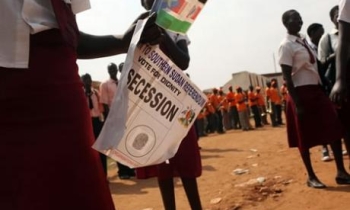Newspaper circulations worldwide rose 2.3 per cent in 2006 while newspaper advertising revenues showed substantial gains, the World Association of Newspapers announced Monday.
WAN said global newspaper sales were up 2.3 per cent over the year, and had increased 9.48 per cent over the past five years. Newspaper sales increased year-on-year in Asia, Europe, Africa, South America, with North America the sole continent to register a decline. The survey, which WAN has published annually since 1986, this year includes information on all countries and territories where newspapers are published — 232.

When free dailies are added to the paid newspaper circulation, global circulation increased 4.61 per cent last year, and 14.76 per cent over the past five years. Free dailies now account for nearly 8 per cent per cent of all global newspaper circulation and 31.94 per cent in Europe alone.
Advertising revenues in paid dailies were up 3.77 per cent last year from a year earlier, and up 15.77 per cent over five years, WAN said. No figures were available for free daily advertising revenues.
"Newspapers in developing markets continue to increase circulation by leaps and bounds, and in mature markets are showing remarkable resilience against the onslaught of digital media. Even in many developed nations the industry is maintaining or even increasing sales," said Timothy Balding, Chief Executive Officer of the Paris-based WAN. "At the same time, newspapers are exploiting to the full all the new opportunities provided by the digital distribution channels to increase their audiences.
"As the digital tide gathers strength, it is remarkable that the press in print continues to be the media of preference for the majority of readers who want to remain informed."
Balding added: "These results are even better than we expected from provisional data available a few months ago. Once again we can see that far from being an industry in decline, as the ill-informed and short-sighted continue to contend, newspapers are alive and well and exhibiting enormous innovation and energy to maintain their place as the news media of preference for hundreds of millions of people daily.”

The new data, from WAN's annual survey of world press trends, was released to more than 1,600 publishers, editors and other senior newspaper executives from 109 countries attending the 60th World Newspaper Congress and 14th World Editors Forum in Cape Town, South Africa. The main figures showed that global circulations and advertising revenues are increasing worldwide. In addition, the free daily market is giving renewed impetus to newspaper reading, and newspaper web traffic continues high growth.
Paid circulation grew 2.3 per cent worldwide in 2006 from a year earlier, taking global sales to a new high of more than 515 million daily. With free dailies added, daily circulation increases to nearly 556 million, a 4.61 per cent increase from the total of paid and free dailies in 2005.
The total number of paid-for daily titles was up 3.46 per cent in the world in 2006 and up 17.67 per cent since 2002 to a record 11,207 titles. The total number of paid and free titles increased by 4.33 per cent in 2006 and by 19.63 per cent since 2002.
Newspaper advertising revenue increased 3.77 per cent in 2006 from a year earlier, and was up 15.77 per cent over five years.
Paid daily newspaper circulations were up in 31 per cent of the countries surveyed in 2006, stable in half the countries and down in 19 per cent. Over the past five years, newspaper circulations were up in more than half of the countries surveyed and stable in 20 per cent.
More than 515 million people buy a newspaper every day, up from 488 million in 2002. Average readership is estimated to be more than 1.4 billion people each day. Seven of 10 of the world's 100 best selling dailies are now published in Asia. China, Japan and India account for 60 of them.
The five largest markets for newspapers are: China, with 98.7 million copies sold daily; India, with 88.9 million copies daily; Japan, with 69.1 million copies daily; the United States, with 52.3 million; and Germany, 21.1 million.
Circulation sales were up 3.61 per cent in Asia in 2006 over the previous year, up 4.55 per cent in South America, up 0.74 per cent in Europe, up 0.65 per cent in Africa, up 2.11 per cent in Australia and Oceania, and down -1.97 per cent in North America.

The number of paid-for newspaper titles increased everywhere but South America, where it was stable. The number of newspaper titles was up 7 per cent in Asia, 1.3 per cent in Europe, 0.67 per cent in North America, 1.2 per cent in Africa and 1.14 per cent in Australia and Oceania.
Daily paid newspapers in Europe saw a 0.74 per cent increase in circulation in 2006, and a 4.12 per cent decrease over five years. When free dailies are added, circulation increased 10.19 per cent year-on-year and 12.84 per cent over five years.
In the European Union, paid daily newspapers saw a 0.87 per cent per cent drop in 2006 and a 5.63 per cent drop since 2002. Combined with free dailies, circulation in the EU rose 7.56 per cent over one year and 12.22 per cent over five years.
Newspapers in 10 European Union countries increased their total circulation in 2006. They were: Austria 9.43 per cent, Estonia 7.81 per cent, Ireland 5.54 per cent, Italy 1.88 per cent, Lithuania 1.52 per cent, Malta 5.26 per cent, Poland 2.13 per cent, Portugal 8.95 per cent, Romania 25.70 per cent, and Slovakia 1.09 per cent. Circulation was stable in Cyprus.
Those reporting losses were: Belgium 2.86, Czech Republic 1.78, Denmark 1.71, Finland 0.71, France 1.55, Germany 2.1, Greece 4.85, Hungary 0.62, Latvia 7.76, Luxembourg 0.87, the Netherlands 2.07, Slovenia 18.60, Spain 2.14, Sweden 2.14 and the United Kingdom 2.66.
Over the five years 2002-2006, circulation rose in nine countries: Austria 10.25 per cent, Cyprus 11.11 per cent, Czech Republic 1.24 per cent, Estonia 8.24 per cent, Ireland 35.36 per cent, Malta 25 per cent, Poland 24.95 per cent, Portugal 12.70 per cent, and Slovenia 1.74 per cent.

In the same period, circulation declined in: Belgium 3.46 per cent, Denmark 11.5 per cent; Finland 1.94 per cent; France 5.70 per cent; Germany 9.35 per cent; Greece 2.79 per cent; Hungary 9.03 per cent; Italy 4.49 per cent; Latvia 17.05, Luxembourg 3.39, Netherlands 11.13 per cent; Slovakia 9.18 per cent; Spain 1.13 per cent; Sweden 3.95 per cent and the United Kingdom 12.5 per cent.
Elsewhere in Europe, circulation in 2006 increased 2.80 per cent in Turkey and 36.25 per cent in Croatia. It declined 2.91 per cent in Norway, and 2.54 per cent in Switzerland. Over five years, the decline was 10.1 per cent in Norway, 9.64 per cent in Switzerland and 6.20 per cent in Croatia, while it climbed 55.57 per cent in Turkey.
The number of paid-for newspaper titles in the EU climbed 0.41 per cent in 2006, to 1,482, and was up 3.2 per cent over five years. When paid and free titles are combined, the number of titles rose 2.57 per cent over one year and 8.44 per cent over five years.
The circulation of US dailies fell 1.9 per cent in 2006 and 5.18 per cent over five years. Most of the decline came in evening dailies, which saw a year-on-year circulation decline of 4.62 per cent, compared to only 1.48 per cent for morning dailies. Over the past five years, evening dailies declined 19.62 per cent, compared to a 2.52 per cent drop for morning newspapers.
In Japan, newspaper sales fell by 0.83 per cent in 2006. Over five years, sales were down 2.42 per cent. China newspaper sales continue to perform well, up 2.27 and 15.53 per cent over one and five years.
In Latin America, where it has been difficult to obtain reliable data, Brazilian newspaper sales were up 6.50 per cent in 2006 and up 3.70 per cent over five years. Colombia newspaper sales increased 3.23 per cent in 2006 but were down 11.1 per cent over five years.

Indian newspaper sales increased 12.93 per cent in 2006 and 53.63 per cent in the five-year period. Elsewhere in Asia, sales were up in Malaysia (1.82 per cent), Singapore (4.06 per cent), Bangladesh (8.3 per cent) and Korea (10.59 per cent) over one year, and down in Taiwan (6.67 per cent). Over five years, sales rose in Taiwan (2.44 per cent), Malaysia (19.97 per cent), Singapore (0.48 per cent), Thailand (12.31 per cent), Bangladesh (30 per cent) and Korea (19 per cent).
Sales in Australia recorded an increase of 2.95 per cent in 2006 and were stable over five years, while New Zealand newspaper sales were down 1.10 year-on-year and down 3.22 per cent over five years.
In Africa, sales were up 8.24 per cent in South Africa in 2006, and 43.18 per cent over five years. Sales were stable in Nigeria and Kenya in 2006 and up 7.89 per cent and 1.90 per cent respectively over five years.
The Japanese remain the world's greatest newspaper buyers, with 630.9 daily sales per thousand adults. They are followed by Norway with 601.2 sales per thousand, Colombia with 587.8, Finland with 514.7 and Sweden with 466.2.
The Belgians spend the most time with their newspapers — 54 minutes a day — followed by the Chinese, Finns and Brazilians, with 48 minutes each, on average.
Sunday newspaper circulations declined 3.69 per cent in 2006 and 6.2 per cent over five years. The United States and the United Kingdom remain the largest markets for Sunday papers by far. Circulation for non-daily newspapers rose 7.29 per cent over one year and 18.68 per cent over five years.
Global newspaper advertising revenues have increased for four straight years and were up 3.77 per cent in 2006.

Newspapers share of the world ad market held relatively steady with 29.6 per cent, marginally down from 29.8 per cent in 2005. Newspapers remain the world's second largest advertising medium, after television, with more revenue that radio, cinema, outdoor, magazines and the internet combined. When newspapers and magazines are combined, print is the world's largest advertising medium, with a 42 per cent share, compared to 38 per cent for television.
Seventeen countries saw newspaper advertising market share growth in 2006: Austria, Belgium, Switzerland, Czech Republic, Greece, Indonesia, India, Hong Kong, Colombia, Mexico, Puerto Rico, Bahrain, Kuwait, Oman, Qatar, United Arab Emirates, and South Africa.
Over five years, newspapers in 12 countries and territories saw increased market share: Austria, Denmark, Greece, Poland, Russia, Slovenia, Taiwan, Puerto Rico, Kuwait, Oman, Saudi Arabia and the United Arab Emirates.
Newspaper advertising revenues in the US, by far the largest newspaper advertising market in the world, decreased by 1.68 per cent in 2006 but increased by 5.69 per cent over the last five years.
In Japan, ad expenditures declined in 2006 by 3.20 per cent but were up 10 per cent over the past five years. China saw an increase in advertising revenues of 16 per cent last year, and 58 per cent over five years.
Newspaper markets in the European Union saw a 1.36 per cent increase in newspaper advertising revenues in 2006, and a 39.54 per cent increase over five years.
Twenty-one of 24 EU countries for which data was available showed increases in advertising revenue in 2006: Austria 5.7 per cent, Belgium 19 per cent, Bulgaria 71.90 per cent, Czech Republic 12.47 per cent, Denmark 0.53 per cent, Estonia 15.64 per cent, Finland 2.50 per cent, France 1.37 per cent, Germany 1.13 per cent, Greece 1.45 per cent, , Ireland 4.49 per cent, Italy 3.77 per cent, Latvia 4.87 per cent, Lithuania 6.12 per cent, Luxembourg 43 per cent, Poland 11 per cent, Romania 11.18 per cent, Slovakia 11 per cent, Slovenia 20.96 per cent, Spain 0.21 per cent, and Sweden 0.05 per cent,
Newspaper advertising revenue declined in Hungary (6.49 per cent), the Netherlands (0.46 per cent), and the United Kingdom (4 per cent).

Over five years, advertising revenues was up in all 23 countries for which data was available: Austria 50.38 per cent, Belgium 107.5 per cent, Bulgaria 3.98 per cent, the Czech Republic 91.74 per cent, Denmark 42.71 per cent, Estonia 124.68 per cent, Finland 2.5 per cent, France 33.80 per cent, Germany 20.14 per cent, Greece 57.20 per cent, Hungary 62.88 per cent, Ireland 63 per cent, Italy 39.53 per cent, Latvia 49.66 per cent, Lithuania 71.85 per cent, Luxembourg 43.24 per cent, Netherlands 54.74 per cent, Poland 200 per cent, Romania 111.57 per cent, Slovakia 179 per cent, Spain 0.51 per cent, Sweden 46.7 per cent, and the United Kingdom 25 per cent.
In India, newspaper advertising revenues increased 23.18 per cent over one year and 85 per cent over the last five. South Africa also saw remarkable gains — 20.71 per cent over one year and 141 per cent over five years. Turkey's percentage gains were 3.01 per cent in 2006 and 152 per cent over the past five years.
In Australia revenues were down 2.77 per cent over one year but rose 65.44 per cent over five years. New Zealand saw a marginal 0.84 per cent gain last year and an increase of 33.28 per cent over five years.
A total of 287 free daily newspapers had a combined circulation of 40.7 million daily, a circulation increase of 55 per cent over one year and 241 per cent over five years. Twenty-seven million of those daily copies are distributed in Europe alone.
The five largest free dailies are Metro in the United Kingdom (1.13 million copies), Leggo in Italy (1.05 million), 20 Minutos in Spain (997,000), Que! in Spain (970,000), and ADN in Spain (914,000).









